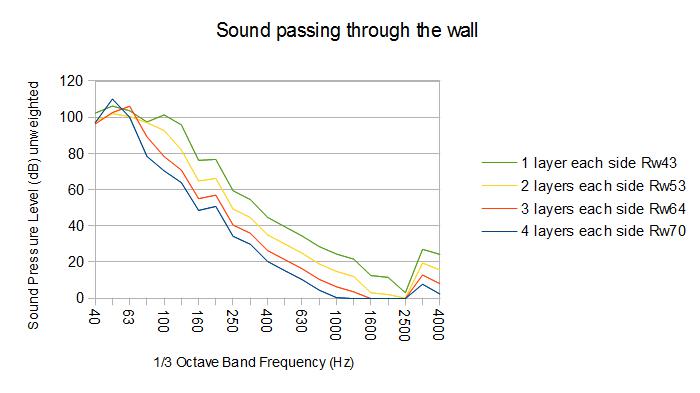Low Frequency Wall Isolation for Studios and Home Theatres – Or why the Building Code and Plasterboard Manufacturers Get it Wrong.
The reason that this is even a topic for discussion is the nature of the spectrum of sound in music and movies. There is a LOT of low frequency energy in both. Much more than what is in sound that common building methods are designed for. Building codes and systems are driven by sources like speech, traffic and light activity like cooking and washing, and of course cost. These sources have very little low frequency content and hence the rules and systems built around them fail significantly at low frequency – and hence why we always hear the “doof doof” of music, movies and games through such walls. In fact, the standard practices can make the wall WEAKER at low frequency.
A cavity wall (a stud with plasterboard each side and some insulation inside) has a resonant frequency just like a drum. At resonance the wall has minimum soundproofing and will pass the most sound – this area is where the graphs dip around 50 to 100 Hz. Above this, from say 160Hz, the walls are dominated by the mass in them and adding more plasterboard provides more soundproofing. (note that each extra layer adds less benefit each time). At resonance however, adding mass just changes the resonance, a bit like a thicker guitar string is as loud as a thin one but the have a different resonance so one has a lower pitch than the other. In the case of the wall trying to soundproof against music or movies, where the sound energy is highest at around 50Hz, you can see that adding layers of plasterboard adds no extra soundproofing and actually moves the resonance to a lower frequency where the problem is worse (louder sound in the source).
The second graph is another way of looking at this and shows how much sound gets through the wall. Where the “doof doof” is, the wall with more plasterboard is actually WORSE.
So the message is not only that adding more plasterboard may make matters worse for soundproofing studios or home theatres, but that adding layers more than two decreases in value rapidly as well. The second layer doubled the cost of plasterboard for an extra 10dB, the third layer tripled the cost but only added 7dB and the 4th layer only added 6dB.
The solution to the low frequency isolation of cavity walls dilemma is to use constrained layer damping (CLD). CLD is designed to damp the resonance and increase the soundproofing at low frequency. For more details of CLD systems click here. or contact us at www.ultrafonc.com.au


